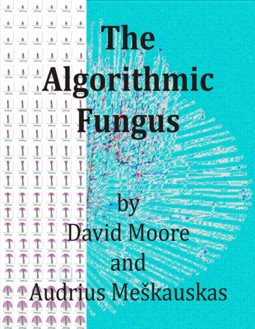World of Cyberfungi? What’s that?
Well, if you want the technical description it’s a set of interactive computer models that simulate the way fungi grow in three-dimensional space. We call it the Neighbour-Sensing mathematical model of hyphal growth, and the mathematics and computer programs were worked out by Audrius Meškauskas.
The less technical description is that it’s a fun way to watch virtual fungi ‘growing’ on your device’s screen (and then ‘clean it off’ at the click of a button). The apps that make up the modelling program allow you to change the characteristics of the growing fungus.
Things like the amount of branching, angle of branching and whether hyphal threads stay together or grow apart (among several other features) can all be changed to establish their effect on the way the simulated hyphae grow. The ultimate, controllable, and most realistic cyberfungus on your own computer.
We have used the Neighbour-Sensing mathematical model of hyphal growth to study fungal networks. Our three-dimensional simulation of growing fungi is an experimental tool. It is not a game or a painting program.
Rather, it provides the user with a way of experimenting with features that may regulate hyphal growth patterns to arrive at suggestions that could be tested with live fungi.
If you stick with these pages, we’ll give you a complete outline of the science and mathematics that underpin the Neighbour-Sensing model of hyphal growth, but if you want to go straight to our research papers you can start in the information box at the bottom of this page.
Check out our pages about our remarkable Neighbour-Sensing model by using the hyperlinks below EITHER to view the online pages of the website OR to download a PDF version of those pages (CLICK HERE for a PDF version of this page):
- Turning real fungi into cyberfungi OR fetch a PDF version
- Fungal dynamics: how real fungi grow OR fetch a PDF version
- Overview of the Neighbour-Sensing model without the maths OR fetch a PDF version
- Mathematical description of the Neighbour-Sensing Model OR fetch a PDF version
- Experimental use of the model OR fetch a PDF version
- Liam McNulty’s Guide to experiments with the Neighbour-Sensing model of mycelial growth OR fetch a PDF version
- Some more examples we prepared earlier OR fetch a PDF version
- Modelling gravitropism in mushrooms (and other organisms) OR fetch a PDF version
- Neighbour-Sensing documentation OR fetch a PDF version
If you want to go straight to our research papers, we recommend that you read these three in this order:The text above gives a brief outline of the kernel of the Neighbour-Sensing mathematical model. All the details about the original model and the enhancements that have now been completed have been published in our research papers, which include an extensive collection of examples and experimental results. You can download reprints of these publications as (free) PDF files from the hyperlinks immediately below. (1) Moore, D., McNulty L. J. & Meškauskas, A. (2004). Branching in fungal hyphae and fungal tissues: growing mycelia in a desktop computer. An invited chapter for the book Branching Morphogenesis, ed. J. Davies published by Landes Bioscience Publishing/Eurekah.com [published on line at http://www.eurekah.com/isbn.php?isbn=1-58706-257-7&chapid=1849&bookid=125&catid=20]. DOWNLOAD a PDF file of a replica of the published paper using this hyperlink (2) Meškauskas, A., McNulty, L. J. & Moore, D. (2004). Concerted regulation of all hyphal tips generates fungal fruit body structures: experiments with computer visualisations produced by a new mathematical model of hyphal growth. Mycological Research 108, 341-353. DOWNLOAD a PDF file of the published paper using this hyperlink (3) Meškauskas, A., Fricker, M. D. & Moore, D. (2004). Simulating colonial growth of fungi with the Neighbour-Sensing model of hyphal growth. Mycological Research 108, 1241-1256. DOWNLOAD a PDF file of the published paper using this hyperlink CHECK OUT this short note to see what our colleagues thought about the Neighbour-Sensing Model |
Buy the book of the website...
 |
The Algorithmic
Fungus Complete details (and code listing) of a computer program that creates life-like and three-dimensional simulations of growing fungal mycelia and tissues. Grow your own cyberfungi in your computer! Buy the PDF here for $10 Delivered by SendOwl CLICK HERE to visit the website VIEW the printed book on Amazon |
 |
Nothing you see here is fake. It's all true. Merely controlled
© Audrius Meškauskas and David Moore 2019

